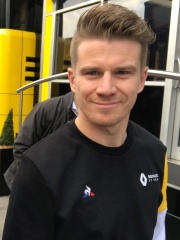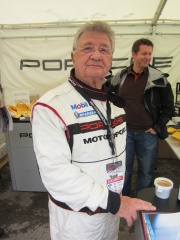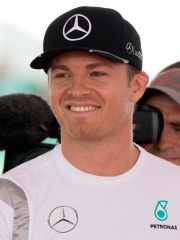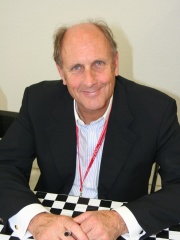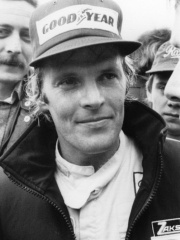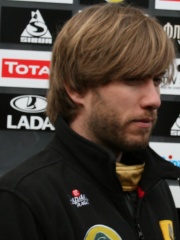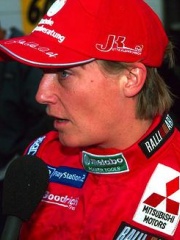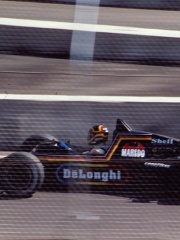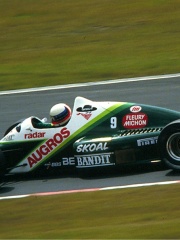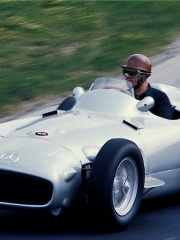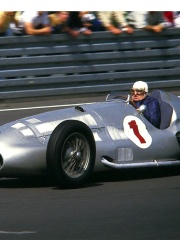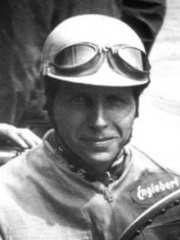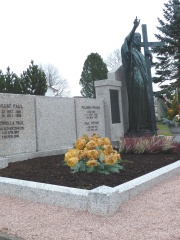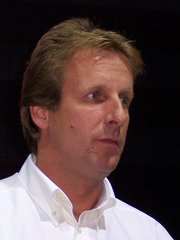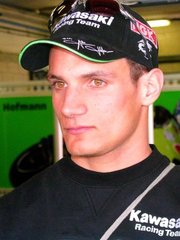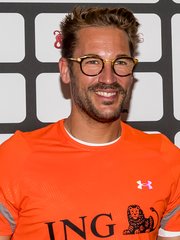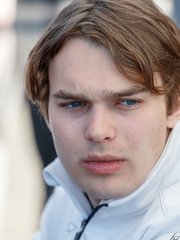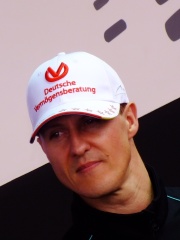
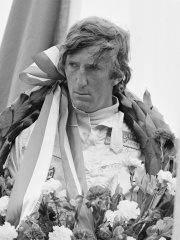
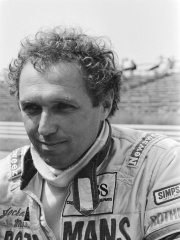
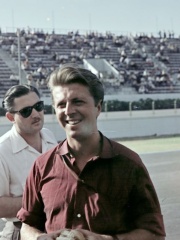
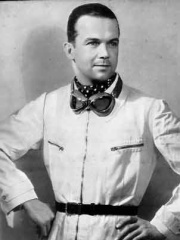
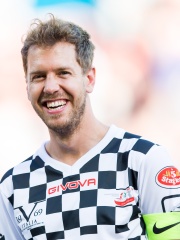
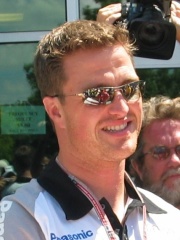
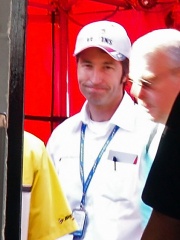
The Most Famous
RACING DRIVERS from Germany
This page contains a list of the greatest German Racing Drivers. The pantheon dataset contains 1,080 Racing Drivers, 77 of which were born in Germany. This makes Germany the birth place of the 5th most number of Racing Drivers behind United States, and France.
Top 10
The following people are considered by Pantheon to be the top 10 most legendary German Racing Drivers of all time. This list of famous German Racing Drivers is sorted by HPI (Historical Popularity Index), a metric that aggregates information on a biography's online popularity. Visit the rankings page to view the entire list of German Racing Drivers.

1. Michael Schumacher (b. 1969)
With an HPI of 80.17, Michael Schumacher is the most famous German Racing Driver. His biography has been translated into 145 different languages on wikipedia.
Michael Schumacher ( SHOO-mak-ər, US also -mahk-, German: [ˈmɪçaʔeːl ˈʃuːmaxɐ] ; born 3 January 1969) is a German former racing driver who competed in Formula One from 1991 to 2006 and from 2010 to 2012. Schumacher won a record-setting seven Formula One World Drivers' Championship titles, tied by Lewis Hamilton in 2020, and—at the time of his retirement—held the records for most wins (91), pole positions (68), and podium finishes (155), while he maintains the record for most fastest laps (77), among others. Born in Hürth to a working-class family, Schumacher began competitive kart racing aged four in a pedal kart built from discarded parts. After a successful karting career—culminating in his victory at the direct-drive Karting European Championship in 1987—Schumacher graduated to junior formulae. He dominated Formula König in his debut season, before graduating to German Formula Three in 1989, where he finished third. He won the title the following season, also claiming the Macau Grand Prix and becoming a race-winner in the World Sportscar Championship with Sauber Mercedes. Schumacher made his debut Formula One appearance with Jordan at the Belgian Grand Prix in 1991; his qualifying performance saw Benetton sign him for the remainder of the season. In 1992, he achieved his maiden victory in Belgium amongst several podiums, which he repeated at the Portuguese Grand Prix in 1993. Schumacher won his maiden World Drivers' Championship with eight victories in 1994, following a collision with his rival, Damon Hill, at the last race of the season. He won a further nine Grands Prix as he defended his title in 1995. Schumacher moved to the struggling Ferrari for his 1996 campaign, where he took several victories and finished third overall. He was involved in title battles in 1997 and 1998, being disqualified from the former for a collision with Jacques Villeneuve and finishing runner-up to Mika Häkkinen in the latter. His rivalry with Häkkinen continued into 1999, when Schumacher broke his leg following a brake failure whilst second in the championship. He returned to beat Häkkinen to his first title with Ferrari in 2000, their first in 21 years, which he successfully defended in 2001. His 2002 campaign—during which he won a then-record 11 Grands Prix—saw him claim a record-equalling fifth title with an unparalleled perfect podium rate. He then claimed his unprecedented sixth and seventh titles, holding off Kimi Räikkönen and Juan Pablo Montoya in the former before winning 13 of 18 Grands Prix during the latter, breaking several further records. After dropping to third in 2005 and narrowly finishing runner-up to Fernando Alonso in 2006, Schumacher announced his retirement from Formula One. He later returned with the resurrected Mercedes from 2010 to 2012, claiming his final podium at the latter European Grand Prix, and has been credited with elevating the project to championship-winning form. Schumacher was noted for pushing his machinery to the limit for sustained periods, as well as his pioneering fitness regimen, win-at-all-costs mentality, and ability to galvanise teams around him. Appointed a UNESCO Champion for Sport in 2002, Schumacher has been involved in several humanitarian projects and has donated over US$65 million to various charities. In December 2013, Schumacher suffered a traumatic brain injury in a skiing accident and was placed in an induced coma for six months. He received further rehabilitation in Lausanne before being relocated to receive private treatment at his home in September 2014; he has not appeared publicly since.

2. Jochen Rindt (1942 - 1970)
With an HPI of 71.95, Jochen Rindt is the 2nd most famous German Racing Driver. His biography has been translated into 46 different languages.
Karl Jochen Rindt (German: [ˈjɔxn̩ ˈʁɪnt]; 18 April 1942 – 5 September 1970) was a racing driver who competed under the Austrian flag in Formula One from 1964 to 1970. Rindt won the Formula One World Drivers' Championship in 1970 with Lotus, and remains the only driver to have won the World Drivers' Championship posthumously, following his death at the Italian Grand Prix; he won six Grands Prix across seven seasons. In endurance racing, Rindt won the 24 Hours of Le Mans in 1965 with NART. Born in Germany and raised in Austria, Rindt started motor racing in 1961. Switching to single-seaters in 1963, he was successful in both Formula Junior and Formula Two. In 1964, Rindt made his debut in Formula One at the Austrian Grand Prix, before securing a full drive with Cooper for 1965. After mixed results with the team, he moved to Brabham for 1968 and then Lotus in 1969. It was at Lotus that Rindt found a competitive car, although he was often concerned about the safety of the notoriously unreliable Lotus vehicles. He won his first Formula One race at the 1969 United States Grand Prix. He had a very successful 1970 season, mainly racing the revolutionary Lotus 72, and won five of the first nine races. In practice for the Italian Grand Prix at Monza, he spun into the guardrails after a failure on his car's brake shaft, and a poorly installed crash barrier gave way. Rindt was pronounced dead while on the way to hospital. As his closest competitor Jacky Ickx was unable to score sufficient points in the remaining races of the season, Rindt was awarded the World Championship posthumously. Rindt left behind his wife, Nina, and a daughter, Natasha. Overall, he competed in 62 Grands Prix, winning six and achieving 13 podium finishes. He was also successful in sports car racing, winning the 1965 24 Hours of Le Mans paired with Masten Gregory in a Ferrari 250LM. Rindt was a popular figure in Austria and his success resulted in increased interest in motorsport and Formula One in particular. He hosted a monthly television show titled Motorama and set up a successful exhibition of racing cars in Vienna. During his time in Formula One, he was involved alongside Jackie Stewart in a campaign to improve safety in Formula One.

3. Jochen Mass (1946 - 2025)
With an HPI of 68.56, Jochen Mass is the 3rd most famous German Racing Driver. His biography has been translated into 30 different languages.
Jochen Richard Mass (German pronunciation: [ˈjɔxn̩ ˈʁɪçaʁt maːs]; 30 September 1946 – 4 May 2025) was a German racing driver and broadcaster, who competed in Formula One from 1973 to 1982. Mass won the 1975 Spanish Grand Prix with McLaren. In endurance racing, Mass won the 24 Hours of Le Mans in 1989 with Sauber. Born and raised in Bavaria, Mass made appearances in Formula Super Vee, Formula Three, and European Formula Two throughout his early career. He finished runner-up in the latter in 1973, having already taken victory at the 24 Hours of Spa alongside Hans-Joachim Stuck the year prior. Mass made his Formula One debut at the 1973 British Grand Prix with Surtees, making sporadic appearances before achieving a full-time seat in 1974. Mass moved to McLaren from the Canadian Grand Prix onwards, where he achieved his only race win at the curtailed 1975 Spanish Grand Prix. In his final season with McLaren in 1977, having taken several podiums with the team, Mass finished a career-best sixth in the World Drivers' Championship. After a non-classified championship finish in 1978 with ATS, Mass spent two seasons at Arrows. He was seriously injured at the 1980 Austrian Grand Prix, bruising his neck and fracturing vertebrae as his Arrows A3 rolled over during practice. After a year hiatus, Mass returned in 1982 with March. Following his crash with Mauro Baldi at the 1982 French Grand Prix—only two months after his involvement in the death of Gilles Villeneuve—Mass retired from Formula One, having achieved one win, two fastest laps, and eight podiums. Outside Formula One, Mass entered 12 editions of the 24 Hours of Le Mans from 1972 to 1995, winning in 1989 alongside Manuel Reuter and Stanley Dickens, driving the Sauber C9, as well as finishing runner-up in the World Sportscar Championship, matching his result from 1984. He also finished runner-up at Le Mans in 1982 with Porsche. Mass was the champion of the Deutsche Rennsport Meisterschaft in 1985, as well as twice finishing runner-up in Interserie, all with Joest. Mass was also a race-winner in the British Saloon Car Championship. Upon retiring from motor racing, Mass became a commentator for RTL from 1993 to 1997. Mass made frequent appearances at Goodwood events from the 1990s onwards, including the Festival of Speed and the Revival. In popular culture, Mass appeared as himself in Rush (2013).

4. Wolfgang von Trips (1928 - 1961)
With an HPI of 66.78, Wolfgang von Trips is the 4th most famous German Racing Driver. His biography has been translated into 31 different languages.
Wolfgang Alexander Albert Eduard Maximilian Reichsgraf Berghe von Trips (German pronunciation: [ˈvɔlfɡaŋ fɔn tʁɪps] ; 4 May 1928 – 10 September 1961), also known as Wolfgang Graf Berghe von Trips, was a German racing driver, who competed in Formula One from 1956 to 1961. Nicknamed "Taffy", von Trips was posthumously runner-up in the Formula One World Drivers' Championship in 1961 with Ferrari, and won two Grands Prix across six seasons. Born in Cologne and raised in Kerpen, von Trips was born into a noble Rhineland family as an aristocrat and count of the Free State of Prussia. After struggling with agriculture, von Trips moved into motor racing. He made his Formula One debut at the 1956 Italian Grand Prix with Ferrari, failing to qualify. Von Trips made further appearances for Ferrari in 1957 at the Argentine, Monaco and Italian Grands Prix, scoring his maiden podium at the latter. He made regular appearances with the team in 1958, taking another podium at the French Grand Prix. Von Trips made two appearances for Porsche in 1959 before returning to Ferrari at the season-ending United States Grand Prix, with whom he scored regular points finishes throughout his 1960 campaign, finishing seventh in the championship. Whilst leading the 1961 World Drivers' Championship, having taken his maiden victory at the Dutch Grand Prix and claiming his second at the British Grand Prix, von Trips died as a result of an accident during the Italian Grand Prix at Monza. After a collision with Jim Clark, von Trips lost control of his Ferrari 156, fatally wounding himself and 15 spectators as his car went airborne. Ferrari withdrew from the remaining United States Grand Prix—having already won the World Constructors' Championship—with teammate Phil Hill taking the title by one point to von Trips.
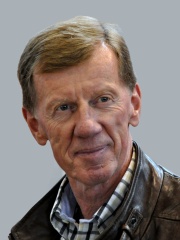
5. Walter Röhrl (b. 1947)
With an HPI of 66.42, Walter Röhrl is the 5th most famous German Racing Driver. His biography has been translated into 28 different languages.
Walter Röhrl (German pronunciation: [ˈvaltɐ ˈʁøːɐ̯l] ; born 7 March 1947) is a German rally and auto racing driver, with victories for Fiat, Opel, Lancia and Audi as well as Porsche, Ford and BMW. Röhrl had 14 victories over his career, with his notable achievements including winning the World Rally Championship twice: in 1980 in a Fiat Abarth and in 1982 while driving for an Opel. He has also competed in other forms of motorsport, such as an endurance racing, winning in the GTP +3.0 class in the 24 Hours of Le Mans in 1981 with the Porsche System team. Röhrl also set the Pikes Peak International Hill Climb record in 1987 driving, an Audi Sport Quattro S1 E2. He is often regarded as one of the greatest rally drivers of all time.

6. Rudolf Caracciola (1901 - 1959)
With an HPI of 65.49, Rudolf Caracciola is the 6th most famous German Racing Driver. His biography has been translated into 30 different languages.
Otto Wilhelm Rudolf Caracciola (German pronunciation: [ˈʁuːdɔlf ka.ʁaˈtʃi̯o.la]; 30 January 1901 – 28 September 1959) was a German racing driver. He won the European Drivers' Championship, the pre-1950 equivalent of the modern Formula One World Championship, an unsurpassed three times. He also won the European Hillclimbing Championship three times – twice in sports cars, and once in Grand Prix cars. Caracciola raced for Mercedes-Benz during their original dominating Silver Arrows period, named after the silver colour of the cars, and set speed records for the firm. He was affectionately dubbed Caratsch by the German public, and was known by the title of Regenmeister, or "Rainmaster", for his prowess in wet conditions. Caracciola began racing while he was working as apprentice at the Fafnir automobile factory in Aachen during the early 1920s, first on motorcycles and then in cars. Racing for Mercedes-Benz, he won his first two Hillclimbing Championships in 1930 and 1931, and moved to Alfa Romeo for 1932, where he won the Hillclimbing Championship for the third time. In 1933, he established the privateer team Scuderia C.C. with his fellow driver Louis Chiron, but a crash in practice for the Monaco Grand Prix left him with multiple fractures of his right thigh, which ruled him out of racing for more than a year. He returned to the newly reformed Mercedes-Benz racing team in 1934, with whom he won three European Championships, in 1935, 1937 and 1938. Like most German racing drivers in the 1930s, Caracciola was a member of the Nazi paramilitary group National Socialist Motor Corps (NSKK), but never a member of the Nazi Party. He returned to racing after the Second World War, but crashed in qualifying for the 1946 Indianapolis 500. A second comeback in 1952 was halted by another crash, in a sports car race in Switzerland. After he retired, Caracciola worked as a Mercedes-Benz salesman targeting North Atlantic Treaty Organization (NATO) troops stationed in Europe. He died in the German city of Kassel, after suffering liver failure. He was buried in Switzerland, where he had lived since the early 1930s. He is remembered as one of the greatest pre-1939 Grand Prix drivers, a perfectionist who excelled in all conditions. His record of six German Grand Prix wins remains unbeaten.

7. Sebastian Vettel (b. 1987)
With an HPI of 64.58, Sebastian Vettel is the 7th most famous German Racing Driver. His biography has been translated into 89 different languages.
Sebastian Vettel (German pronunciation: [zeˈbasti̯a(ː)n ˈfɛtl̩] ; born 3 July 1987) is a German former racing driver who competed in Formula One from 2007 to 2022. Vettel won four Formula One World Drivers' Championship titles, which he won consecutively from 2010 to 2013 with Red Bull, and remains the youngest-ever World Drivers' Champion; he won 53 Grands Prix across 16 seasons. Born and raised in Heppenheim, Vettel began competitive kart racing aged eight. After a successful karting career—culminating in his victory at the junior direct-drive Karting European Championship in 2001—Vettel graduated to junior formulae. He started his career in Formula BMW ADAC, dominating the championship in 2004 with 18 wins from 20 races. Vettel then progressed to the Formula 3 Euro Series in 2005, taking several victories and finishing runner-up to Paul di Resta the following season. A test driver for BMW Sauber since 2006, Vettel made his Formula One debut at the 2007 United States Grand Prix. Vettel replaced Scott Speed at Toro Rosso after the European Grand Prix for the remainder of the 2007 season, as part of the Red Bull Junior Team. Retaining his seat for 2008, Vettel achieved his maiden pole position and victory at the Italian Grand Prix to become the then-youngest driver to win a Formula One Grand Prix. Vettel was promoted to parent team Red Bull in 2009, taking several wins as he finished runner-up to Jenson Button in the World Drivers' Championship. After winning the title-deciding Abu Dhabi Grand Prix in 2010, Vettel became the youngest-ever Formula One World Drivers' Champion, aged 23. Vettel won his second and third championships in 2011 and 2012, dominating the former and winning the latter amidst a close title battle with Fernando Alonso. Vettel set several records in 2013, winning 13 Grands Prix—including a then-record nine consecutive victories—to claim his fourth consecutive title with Red Bull. After a winless 2014 campaign, Vettel signed for Ferrari, replacing Alonso to partner Kimi Räikkönen; he took several wins in his debut season, finishing third in the standings. Following another winless season in 2016, Vettel emerged as the closest challenger to Mercedes and Lewis Hamilton, finishing runner-up in 2017 and 2018 after achieving several victories across both campaigns. Partnered by Charles Leclerc for 2019, Vettel took the final win of his career at the Singapore Grand Prix before leaving Ferrari at the end of the 2020 season. Vettel joined the recently established Aston Martin in 2021, where he scored his final podium finish at the Azerbaijan Grand Prix. Vettel retired at the end of the 2022 season, having achieved the fourth-most wins (53), fourth-most pole positions (57), fifth-most fastest laps (38), and third-most podium finishes (122) in Formula One. Vettel won the Race of Champions in 2015, further winning the Nations' Cup six consecutive times from 2007 to 2012, representing Germany alongside Michael Schumacher. He is also a prominent environmental and climate activist; since 2023, he has been co-owner of the Germany SailGP Team.

8. Ralf Schumacher (b. 1975)
With an HPI of 64.24, Ralf Schumacher is the 8th most famous German Racing Driver. His biography has been translated into 49 different languages.
Ralf Schumacher (born 30 June 1975) is a German former racing driver and broadcaster, who competed in Formula One from 1997 to 2007. Schumacher won six Formula One Grands Prix across 11 seasons. Born and raised in North Rhine-Westphalia, Schumacher is the younger brother of seven-time Formula One World Champion Michael Schumacher, and the pair remain the only siblings to each win a Formula One Grand Prix. Schumacher began karting at the age of three and achieved early success before making the transition to automobile racing in the German Formula Three Championship and the Formula Nippon series. He first drove in Formula One with Jordan Grand Prix for the 1997 season. Schumacher moved to the Williams team in 1999, finishing sixth in the Drivers' Championship that year. He won his first Grand Prix in 2001, en-route to fourth place in the Drivers' Championship, and subsequently won five more races over the course of two years. Schumacher left Williams at the end of 2004 and joined Toyota Racing in 2005. His performance throughout 2006 and 2007 resulted in Schumacher leaving Formula One as a result of internal pressure. After leaving Formula One, Schumacher joined the Deutsche Tourenwagen Masters (DTM) in 2008, achieving minor success, and retired from motorsport at the end of 2012 to enter a managerial role within DTM, mentoring young drivers. He is now a co-commentator for Sky Sport in Germany.

9. Heinz-Harald Frentzen (b. 1967)
With an HPI of 63.03, Heinz-Harald Frentzen is the 9th most famous German Racing Driver. His biography has been translated into 40 different languages.
Heinz-Harald Frentzen (German pronunciation: [haɪ̯nt͡s ˈha.ʁalt ˈfʁeːn.t͡sn̩]; born 18 May 1967) is a German former racing driver, who competed in Formula One from 1994 to 2003. Frentzen was runner-up in the Formula One World Drivers' Championship in 1997 with Williams, and won three Grands Prix across 10 seasons. Born in Mönchengladbach, Frentzen began his racing career aged 12 in karting, winning several titles including the junior direct-drive German Kart Championship. He progressed to junior formulae in 1985, winning several races in Formula Ford before finishing runner-up in the 1989 German Formula Three Championship amidst a title battle with Karl Wendlinger and Michael Schumacher. After three seasons of racing in Japan, Frentzen signed with Sauber in 1994, making his Formula One debut at the Brazilian Grand Prix. He remained at Sauber—now under Red Bull sponsorship—the following season, achieving his maiden podium at the Italian Grand Prix. After scoring several point finishes in his 1996 campaign, Frentzen joined Williams to replace reigning World Champion Damon Hill alongside Jacques Villeneuve. Frentzen achieved his maiden victory at the San Marino Grand Prix, taking several podiums as he finished runner-up to Villeneuve after Schumacher's collision with him at the last race of the season saw his disqualification from the standings. Williams suffered their first winless season since 1988 with the FW20, prompting his departure to Jordan in a swap with Ralf Schumacher. Frentzen achieved further wins at the French and Italian Grands Prix in 1999, finishing third in the World Drivers' Championship to Mika Häkkinen and Eddie Irvine. After struggling for form in 2000, Frentzen was dropped by Jordan after the 2001 British Grand Prix, swapping with Jean Alesi to join Prost. After Prost went bankrupt at the end of the 2001 season, Frentzen spent two seasons with Arrows and Sauber before retiring at the conclusion of 2003, having achieved three wins, two pole positions, six fastest laps and 18 podiums in Formula One. Outside of Formula One, Frentzen competed full-time in the Deutsche Tourenwagen Masters from 2004 to 2006, as well as competing in the all-star Speedcar Series in both of its seasons. Frentzen entered two editions of the 24 Hours of Le Mans in 1992 and 2008, finishing fourth in class at the latter with Aston Martin.
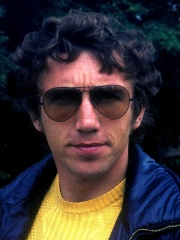
10. Rolf Stommelen (1943 - 1983)
With an HPI of 63.03, Rolf Stommelen is the 10th most famous German Racing Driver. His biography has been translated into 22 different languages.
Rolf Johann Stommelen (German pronunciation: [ʁɔlf ˈjoːhan ˈʃtoːmeln̩]; 11 July 1943 – 24 April 1983) was a German racing driver, who competed in Formula One from 1969 to 1978. In endurance racing, Stommelen was a four-time winner of the 24 Hours of Daytona with Porsche. Stommelen participated in 63 Formula One Grands Prix, achieving one podium and 14 championship points. He also participated in several non-championship Formula One races. He was widely successful in sports car racing from the mid-1960s until his death in 1983, winning the 24 Hours of Daytona four times: in 1968, 1978, 1980 and 1982. He also won the 1967 Targa Florio with Porsche.
People
Pantheon has 81 people classified as German racing drivers born between 1901 and 2000. Of these 81, 48 (59.26%) of them are still alive today. The most famous living German racing drivers include Michael Schumacher, Walter Röhrl, and Sebastian Vettel. The most famous deceased German racing drivers include Jochen Rindt, Jochen Mass, and Wolfgang von Trips. As of April 2024, 5 new German racing drivers have been added to Pantheon including Frank Biela, Alex Hofmann, and Maximilian Götz.
Living German Racing Drivers
Go to all RankingsMichael Schumacher
1969 - Present
HPI: 80.17
Walter Röhrl
1947 - Present
HPI: 66.42
Sebastian Vettel
1987 - Present
HPI: 64.58
Ralf Schumacher
1975 - Present
HPI: 64.24
Heinz-Harald Frentzen
1967 - Present
HPI: 63.03
Nico Hülkenberg
1987 - Present
HPI: 62.78
Hans Herrmann
1928 - Present
HPI: 61.06
Nico Rosberg
1985 - Present
HPI: 61.05
Hans-Joachim Stuck
1951 - Present
HPI: 60.17
Hans Heyer
1943 - Present
HPI: 59.69
Nick Heidfeld
1977 - Present
HPI: 59.60
Jutta Kleinschmidt
1962 - Present
HPI: 58.02
Deceased German Racing Drivers
Go to all RankingsJochen Rindt
1942 - 1970
HPI: 71.95
Jochen Mass
1946 - 2025
HPI: 68.56
Wolfgang von Trips
1928 - 1961
HPI: 66.78
Rudolf Caracciola
1901 - 1959
HPI: 65.49
Rolf Stommelen
1943 - 1983
HPI: 63.03
Stefan Bellof
1957 - 1985
HPI: 61.23
Manfred Winkelhock
1951 - 1985
HPI: 60.63
Karl Kling
1910 - 2003
HPI: 60.56
Hermann Lang
1909 - 1987
HPI: 59.88
Rudi Fischer
1912 - 1976
HPI: 58.33
Kurt Adolff
1921 - 2012
HPI: 57.97
Paul Pietsch
1911 - 2012
HPI: 57.45
Newly Added German Racing Drivers (2025)
Go to all RankingsFrank Biela
1964 - Present
HPI: 48.37
Alex Hofmann
1980 - Present
HPI: 40.05
Maximilian Götz
1986 - Present
HPI: 38.03
Daniel Abt
1992 - Present
HPI: 36.69
David Beckmann
2000 - Present
HPI: 34.76
Overlapping Lives
Which Racing Drivers were alive at the same time? This visualization shows the lifespans of the 25 most globally memorable Racing Drivers since 1700.

